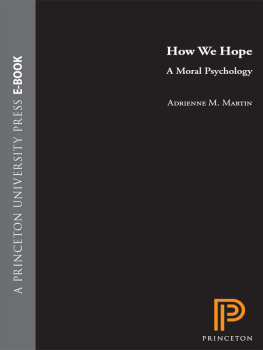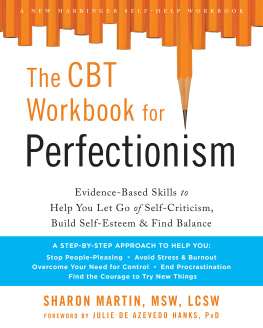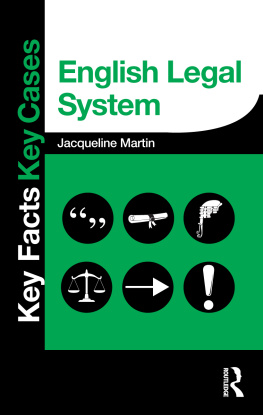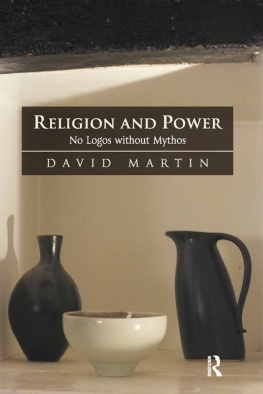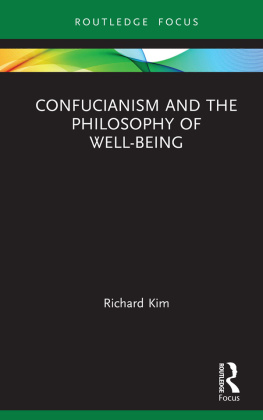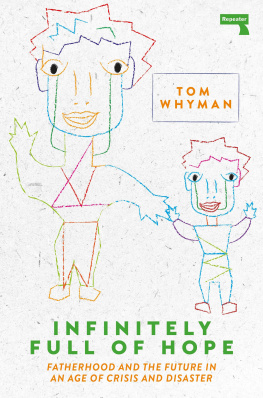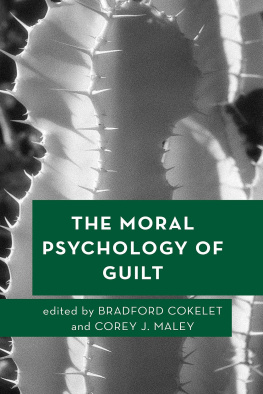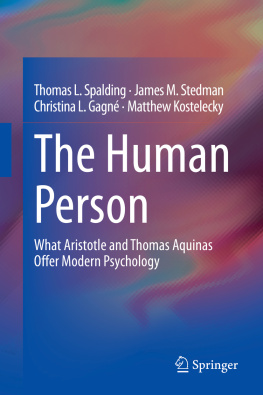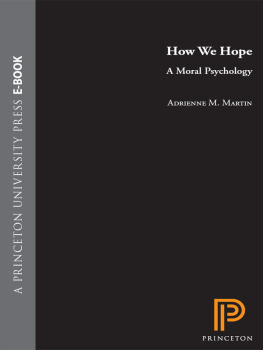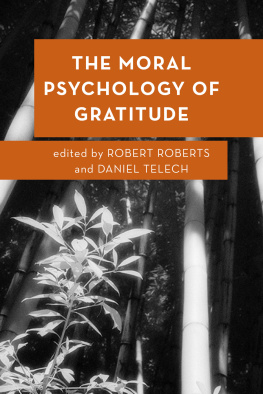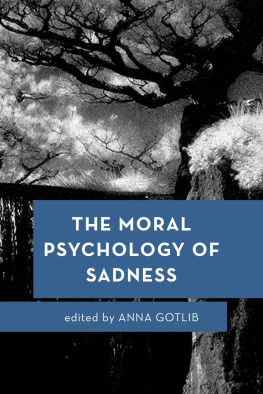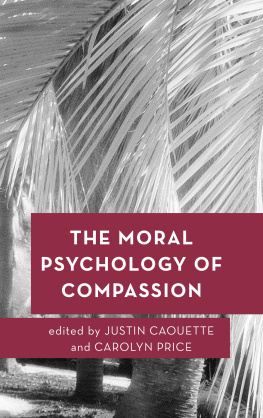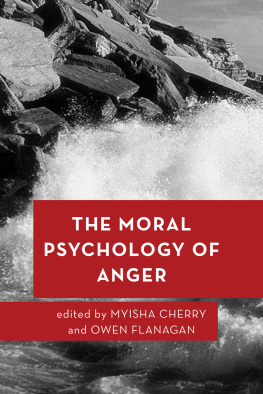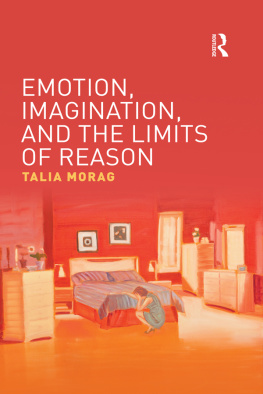Martin - How we hope: a moral psychology
Here you can read online Martin - How we hope: a moral psychology full text of the book (entire story) in english for free. Download pdf and epub, get meaning, cover and reviews about this ebook. City: Princeton, year: 2017;2013, publisher: Princeton University Press, genre: Romance novel. Description of the work, (preface) as well as reviews are available. Best literature library LitArk.com created for fans of good reading and offers a wide selection of genres:
Romance novel
Science fiction
Adventure
Detective
Science
History
Home and family
Prose
Art
Politics
Computer
Non-fiction
Religion
Business
Children
Humor
Choose a favorite category and find really read worthwhile books. Enjoy immersion in the world of imagination, feel the emotions of the characters or learn something new for yourself, make an fascinating discovery.
- Book:How we hope: a moral psychology
- Author:
- Publisher:Princeton University Press
- Genre:
- Year:2017;2013
- City:Princeton
- Rating:5 / 5
- Favourites:Add to favourites
- Your mark:
- 100
- 1
- 2
- 3
- 4
- 5
How we hope: a moral psychology: summary, description and annotation
We offer to read an annotation, description, summary or preface (depends on what the author of the book "How we hope: a moral psychology" wrote himself). If you haven't found the necessary information about the book — write in the comments, we will try to find it.
How we hope: a moral psychology — read online for free the complete book (whole text) full work
Below is the text of the book, divided by pages. System saving the place of the last page read, allows you to conveniently read the book "How we hope: a moral psychology" online for free, without having to search again every time where you left off. Put a bookmark, and you can go to the page where you finished reading at any time.
Font size:
Interval:
Bookmark:

How We Hope
How We Hope
A Moral Psychology
Adrienne M. Martin

Copyright 2014 by Princeton University Press
Requests for permission to reproduce material from this work should be sent to Permissions, Princeton University Press
Published by Princeton University Press, 41 William Street, Princeton, New Jersey 08540
In the United Kingdom: Princeton University Press, 6 Oxford Street, Woodstock, Oxfordshire OX20 1TW
press.princeton.edu
Jacket art: Sigmar Polke, German, 19412010. Hope is: Wanting to Pull Clouds, 1992
Gift of the Collectors Committee 1993.59.1. 2013 National Gallery of Art, Washington, DC. 2013 The Estate of Sigmar Polke, Cologne / ARS, New York / VG Bild-Kunst, Bonn.
Excerpt from Ein Yahav from OPEN CLOSED OPEN: Poems by Yehuda Amichai, translated from the Hebrew by Chana Bloch and Chana Kronfeld. Copyright 2000 by Chana Bloch and Chana Kronfeld. Reprinted by permission of Houghton Mifflin Harcourt Publishing Company. All rights reserved.
English Translation Copyright 2000 by Chana Bloch and Chana Kronfeld. Reprinted by permission of Georges Borchardt, Inc., on behalf of Chana Bloch, Chana Kronfeld, and the Estate of Yehuda Amichai.
All Rights Reserved
Library of Congress Cataloging-in-Publication Data
Martin, Adrienne M.
How we hope : a moral psychology / Adrienne M. Martin.
pages cm
Includes bibliographical references and index.
ISBN 978-0-691-15152-6 (hardcover : alk. paper) 1. Hope. I. Title.
BD216.M37 2013
128dc23 2013014198
British Library Cataloging-in-Publication Data is available
This book has been composed in Adobe Garamond and Myriad
Printed on acid-free paper
10 9 8 7 6 5 4 3 2 1
For Chris
Ein Yahav
A night drive to Ein Yahav in the Arava Desert,
a drive in the rain. Yes, in the rain.
There I met people who grow date palms,
there I saw tamarisk trees and risk trees,
there I saw hope barbed as barbed wire.
And I said to myself: Thats true, hope needs to be
like barbed wire to keep out despair,
hope must be a mine field.
From Yehuda Amichai, Israeli Travel: Otherness is All, Otherness is Love, #7
Translated by Chana Bloch and Chana Kronfeld
Acknowledgments
As documented in the introduction to this book, my interest in hope began during my time as a postdoctoral fellow at the National Institutes of Healths Department of Bioethics. This was a wonderful fellowship that, in many ways, changed the way I think about all subjects. I am especially grateful to Ezekiel Emanuel and David Wendler for pushing me to take hope seriously as a topic of philosophical inquiry.
I wrote the bulk of the manuscript while on leave from the University of Pennsylvania, and during a fellowship at the Princeton University Center for Human Values. I am grateful to both institutions for their support. The Center for Human Values and connected programs and groups at Princeton provide a uniquely stimulating and supportive environment for academic research, and I am indebted to the many, many people who took an interest in my work while I was there. I particularly want to mention Anthony Appiah, Charles Beitz, Elizabeth Harman, Peter Singer, and my fellow fellows: Corey Brettschneider, Tom Christiano, Gerry Mackie, Tim Mulgan, Colleen Murphy, Jonathan Quong, and John Seery. Well after we had returned to our home institutions, Colleen and Jonathan also took the time to provide valuable comments on a complete draft of the book.
Andrew Chignell, David McNaughton, and Nancy Sherman read and commented on the entire manuscript, and the book is much improved as a result (though of course any remaining shortcomings are mine alone). Conversations with Ingra Schellenberg were important to my thoughts in . In addition to providing helpful substantive comments, Chris Melenovsky took the mess of footnotes in an early draft and magicked them into a real set of references. He did a wonderful job preparing the index.
I have received profound supportin relation to this book project, but also more broadly in my career as a philosopherfrom Cheshire Calhoun, Samuel Freeman, Maggie Little, Martha Nussbaum, and Kok-Chor Tan. I am not infrequently overwhelmed at how fortunate I am to have such generous colleagues and mentors.
Sections of the first three chapters contain revised parts of a previously published paper, Hopes and Dreams, and I thank Philosophy and Phenomenological Research for the permission to use this material.
My mother, Valerie Martin, and my partner, Chris Hayes, have been my sounding boards for many years, and I doubt this book would exist without them. Finally, it does truly take a village: Megan Yancey, Ashley Mutch, Katiria Rivera, and Stephanie Roy all provided wonderful care for my beloved daughter, Calliope, during the time I was writing and revising this book.
How We Hope
Introduction
What Is Hope?
Questions about Hope
I first became interested in hope as a subject of philosophical inquiry in 2004, when I took up a postdoctoral fellowship at the National Institutes of Healths Department of Bioethics, and John Kerry began his presidential campaign against George W. Bush. In my daily life, hope was simultaneously an object of such strong approval and suspicion that I began to wonder what, exactly, it is. And, once I started paying close attention to what people said about hope, when they expressed it, and when they reared back from it, I began to think there was a fair amount of confusion about it.
The Department of Bioethics is institutionally and physically inside the NIHs Clinical Center in Bethesda, Maryland, which is where the NIHs clinical researchers carry out their trialsit is a hospital where every patient is a research participant. During my two years there, I spent much of my time following a cancer investigator on his rounds with participants in two phase I trials of Avastin. A phase I trial tests an experimental drug or potential treatment for toxicity and tolerance in humans. It is not until phase II, after the tolerable maximum dosage has been determined at phase I, that researchers begin to test an experimental drugs effectiveness. The participants in phase I trials are either healthy volunteers or terminally ill patients who have exhausted the known treatments for their condition and wish to contribute to research and, perhaps, hope the experimental drug will unexpectedly benefit them. The chances of a participant in a phase I trial receiving medical benefit from the experimental drug are typically less than one percent, and participants are informed of this fact.
The participants in the trials I followed were terminally ill with forms of cancer for which Avastin was not yet approved as a treatment. Genentech (bought by Hoffmann LaRoche in 2009) makes Avastin/bevacizumab, which blocks the growth of blood vessels, including at some tumor sites. In 2004, it was first approved for use in combination with chemotherapy to treat both metastatic colorectal and metastatic small-cell lung cancer. It was, and continues to be, exorbitantly expensive, but many researchers
Hope was a regular topic at the meetings I attended. If the investigator reported stabilized or reduced tumor size, the participant would light up and declare, So, theres hope! If he reported increased tumor size, or raised reasons to think enrollment in a different trial might yield a better chance of medical benefit, the participant would, often, visibly steel him or herself and ask, Is there still hope? (Tumor size is one of the standard measures of a cancer drugs effectiveness, despite the research communitys awareness that there is no correspondence between it and prolonged life or improved quality of life.) While the investigator never raised the topic of hope himself, the Center administrators enthusiastically embraced the unofficial name given the Center at a public event by longtime cancer research participant, Susan Butler: the House of Hope. Hope was emblazoned across press releases, ads for trials, and internal emails at the Center. It would be a feat for anyone entering the Center not to see it as offering hope, and intentionally so. Indeed, this is true of the medical research industry as a whole: hope is the watchword.
Next pageFont size:
Interval:
Bookmark:
Similar books «How we hope: a moral psychology»
Look at similar books to How we hope: a moral psychology. We have selected literature similar in name and meaning in the hope of providing readers with more options to find new, interesting, not yet read works.
Discussion, reviews of the book How we hope: a moral psychology and just readers' own opinions. Leave your comments, write what you think about the work, its meaning or the main characters. Specify what exactly you liked and what you didn't like, and why you think so.

